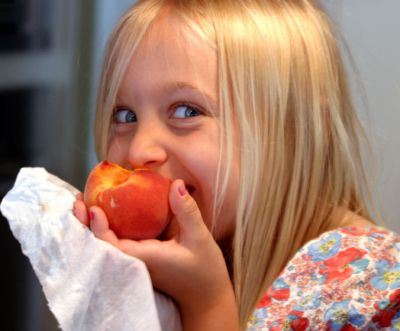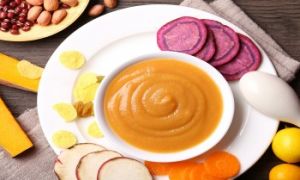“Yuck, I’m not eating that”… I’m sure you have heard your child say this on more than one occasion. Your child is growing up and developing their own ideas and interests on what types of foods they are most likely to eat and enjoy. With all the fast food gimmicks shown on television lately as well as peer pressure from school and popular trends, it can be difficult to establish healthy eating habits with your school age child. Trying to convince your child to eat their vegetables isn't going to always work. The trick is to make healthy choices more appealing.
Importance of Meals for School Age Children
As you may have noticed, your child’s eating pattern begins to change (around the age of 6 years old). Typically they begin to eat three main meals a day with a quick snack in between. Your child’s physical growth is developing at a steady pace so a well-balanced diet is needed to support your child’s growing body. It’s important to offer your child a variety of healthy food throughout each day. This means whole grains, fruits, vegetables, protein and dairy. So, how much variety does your child need each day? Below are recommended dietary guidelines you can use to determine your child’s healthy eating habits.
Nutrition For Your School Age Child
Below is a Recommended Dietary Guidelines for School Age Children
Vegetables - 3 - 5 servings per day.
1 serving =
- 1 cup raw leafy vegetables,
- ¾ cup of vegetable juice or
- ½ cup of other vegetables raw or cooked.
Fruits - 2 – 4 servings per day.
1 serving =
- ½ cup of sliced fruit,
- ¾ cup of fruit juice or
- medium size piece of fruit (apple, banana, pear).
Whole Grains - 6 – 11 servings per day.
1 serving =
- 1 slice of bread,
- ½ cup of rice or
- 30g of cereal.
Protein - 2 – 3 servings of cooked lean meat, poultry or fish per day.
1 serving =
- ½ cup cooked dry beans,
- one egg or
- 2 tbsps. of peanut butter.
Dairy Products - 2 – 3 servings per day of milk or yoghurt.
1 serving =
- 1 cup of milk
- 1 cup of yoghurt (200mL)
- 2 slices of cheese
Zinc - Researchers indicate that 20mg of zinc five times a week may improve memory and school performance, especially in boys. Good sources of zinc are oysters, beef, pork, liver, dried beans and peas, whole grains, fortified cereals, nuts, milk, cocoa and poultry.
Healthy Menu Ideas for School Age Children
When looking through the dietary guidelines it can be really hard to determine how to incorporate each of the recommended servings into your child’s daily eating habits. However you can take into consideration that your child already eats three meals a day (breakfast, lunch and dinner) and also snacks in between. By planning, preparing and choosing the correct types of foods, you can assist your child to develop healthy eating habits. Here are some daily menu ideas based on the dietary guidelines recommended above:
Daily Healthy Menu Ideas for School Age Child:
Breakfast
- Cereal and milk with a piece of toast.
- Wholegrain toast with cheese and tomato and a piece of fruit (or) fruit/vegetable juice.
- Toasted sandwich with a glass of milk.
- Baked beans on toast.
- Yoghurt topped with fresh fruit and a piece of toast.
- Peanut butter sandwich with a banana.
- Oats with honey and strawberries.
Lunch
- Vegetable sticks served with a selection of dips.
- Boiled egg with toasted fingers.
- Homemade pizza with a variety of toppings.
- Pasta salad (add shredded chicken, tomato)
- Mini quiches.
- Tuna sandwich in pita bread.
- Chicken Meatballs with cooked rice.
Dinner
- Vegetable frittata with boiled vegetables.
- Chicken risotto.
- Shepherd’s pie with garden salad.
- Beef tacos.
- Creamy pasta with chicken and mushroom.
- Crumbed barbeque fish with salad.
- Oven roasted chicken and roasted vegetables.
Snacks
- Mini Pikelets (savory or sweet).
- Banana bread.
- Berry thick shakes or smoothies.
- Sweet potato chips (homemade).
- Whole meal muffins.
- Oat cookies.
As you can see the possibilities of preparing a well-balanced meal are endless! There are so many simple food ideas which you can use to prepare healthy foods for your child. By being creative and offering a variety of healthy foods it will definitely go a long way in encouraging your child to choose much healthier options.
How to Promote Healthy Eating
The best way to promote healthy eating and develop healthy eating choices for your school age child is to be a role model yourself. You have a big influence on your child so use it to your advantage and select healthy meal choices for yourself and the whole family. Your child will definitely be watching you and what you are eating, so make a healthy impression. Here are some helpful tips on promoting healthy eating in your family:
Home Cooked Meals – There is nothing like sitting down at the table, eating a yummy home cooked meal. I’m sure when you were growing up, a home cooked meal would have been your favourite thing… Pass on the tradition to your child and prepare a home cooked meal for your family. They are also healthier as well, as you get to control the types of ingredients you use (instead of full fat cream, use low fat cream). When eating out, they tend to use more fat, salts and sugars. However, you can always eat out on special occasions…as long as it’s not every day.
Eating As A Family – There are times when sometimes you don’t get to spend time with your family, even when they are living in the same house! Make it a habit to eat dinner together as a family, at a consistent time, with a home cooked meal each night. It provides a perfect opportunity to spend time together, sharing what has happened at school (or) at work. It also is comforting and enhances appetite knowing that at a specific time dinner will be ready. It could even become the favourite part of the day…
Your Child Chooses – Instead of filling up your child’s plate, let them do it themselves. Why should you control how much your child eats? Pass them an empty plate and let them serve themselves. Your child will feel more comfortable and more likely to eat the vegetables, if they don’t feel forced.
Involve Your Child – Make a shopping list, take your child grocery shopping and giving them the option of selecting what they can have for lunch at school and preparing dinner. Teach them the nutritional value in different foods and choosing which foods is the healthier option. It’s also a good idea to involve your child in the cooking process. Your child will be more inclined to eat something that they helped to prepare.
Make Healthy Food Available – If you want your child to eat healthier, don’t tempt them with junk food. Clean out the pantry and provide a healthier option such as whole grain snacks, plenty of fruits and vegetables, homemade muffins, mini salad wraps and more. This will definitely be a good chance to create healthy eating habits for your child.
How to Encourage Your Child to Eat Fruits and Vegetables
There are often times that your child will simply refuse to eat their vegetables. Simply the look and taste of vegetables can make a child refuse their meal. It’s not going to make the situation any better, forcing your child to eat “you are not leaving the table until you eat your spinach” or screaming at them “EAT THEM NOW”. Realistically if you were being forced or screamed at to eat something you didn't want to eat, how would you feel? Well I can assure you, your child probably feels the same way. Be creative and make mealtimes fun, a little effort goes a long way. Try these tips to bring a little creation to your meals:
- Make frozen fruit kebabs.
- Create rice cake faces (use sultanas for the mouth, apple for the ears, grapes for eyes etc.).
- Mix chopped fruit with jelly (before it sets).
- Camouflage vegetables in other foods (grating carrot and zucchini for pasta sauces, blend vegetables to add to stews and casseroles).
- Try a banana (or) fruit smoothie; just blend a banana (or) another piece of fruit, a cup of milk and a 1 tsp. honey together. Enjoy.
- Add blended/grated fruits (or) vegetables to your baking. Such as strawberry pancakes, olive and cheese bread, carrot cake etc. The possibilities are endless.
- Slice vegetables and keep them in a container where your child can access them. Serve them with dip as a snack.
- Keep fruits washed and available for your child to eat as a snack.
- Take your child shopping with you and let them choose fruits and vegetables to try.
- Add sliced fruit pieces on top of your child’s favourite yoghurt.
- Make fruity icy poles – great during summer.
- Have a make your own pizza night!
Junk Food Alternatives
If your child begins to crave for junk food, you can swap if for a healthier option. That way you are still encouraging healthy eating habits in your family. Below is a list of junk ford alternatives you can try:
- Your Child Wants: Ice – Cream
- You Provide: Frozen yoghurt
- Your Child Wants: Potato Chips
- You Provide: Popcorn (or) rice cakes.
- Your Child Wants: Pizza
- You Provide: Mini wholegrain pita bread pizza
- Your Child Wants: Cakes (or) Cookie
- You Provide: Home- Made Muffins and Oat Cookies.
- Your Child Wants: Milkshakes
- You Provide: Fresh Fruit Smoothies.
- Your Child Wants: Burger
- You Provide: Homemade burger with sweet potato.
- Your Child Wants: Chocolate
- You Provide: A piece of dark chocolate.
- Your Child Wants: Lollies
- You Provide: Low fat/sugar free lollies.
Eating Healthy While Eating Out
Fast food is a quick fix when you just don’t want to cook. Even though eating out is an easier option, you will be consuming more calories and more fat. It’s best while eating out to try and encourage your child to choose a healthier option. Although I know it can be difficulty to convince your child to order water instead of coke but here are some tips to try:
Avoid soft drinks – Don’t give your child the option of choosing soft drink. When going to a restaurant order a jug of water for the whole table. If they must have something to drink, a glass of juice can be an option (it may not be fresh juice, however it’s better than fizzy drinks).
Skip the fries – Order a side of vegetables or mash potato. If your child is making a scene for fries, limit how much fries they can eat. Best way, don’t offer meals that would normally come with fries. For e.g. chicken and vegetables, pasta – spaghetti with tomato sauce, grilled fish with salad, rather than chicken nuggets and fries or macaroni and cheese.
Model healthy food habits – When eating out choose healthy eating options yourself. They are more likely to do as you do, not as you say.
Desserts – When it comes to desserts choose fruit salad/frozen yoghurt or a fruit smoothie instead of cakes and ice-cream.
Best to Order – Here are some examples of healthier options to order while eating out: a single slice of veggie pizza with salad, grilled sandwiches on whole grain bread, a small hamburger, baked potato (small amount of sour cream), grilled chicken (or) fish with salad or roasted vegetables, a chicken burger. It’s easy to make the switch to change your families eating habits. Just maintain a well-balanced diet for you and your entire family.
Choose Healthier Child Meals – Most fast food chains promote healthier options for your child. Whether you’re ordering a pizza or going to McDonald’s choose the healthier option (or) try making it yourself. It’s not difficult to make your own pizzas and burgers.
There are so many options that you can do to promote healthy eating habits with your child. I hope this article provides you with basic guidelines and practical strategies you can use to encourage your child to choose a healthier meal. Remember to get your child involved in preparing meals, be a role model and choose healthier options for yourself by providing a wide variety of foods and make healthier foods available. This will have a huge impact on your child’s relationship with food.
References:
helpguide.org










